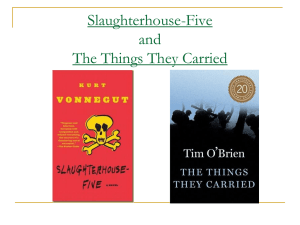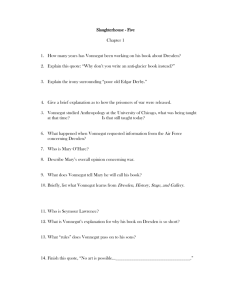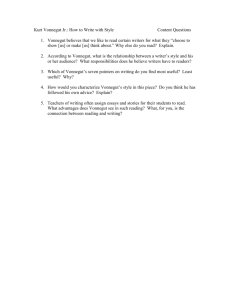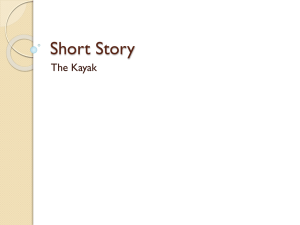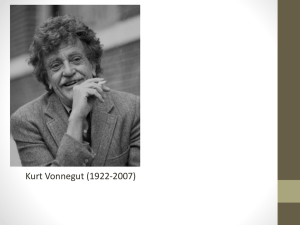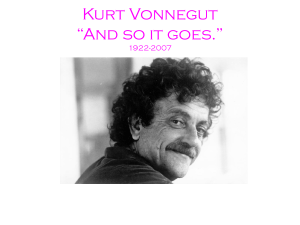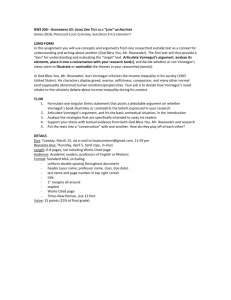Slaughterhouse Five
advertisement
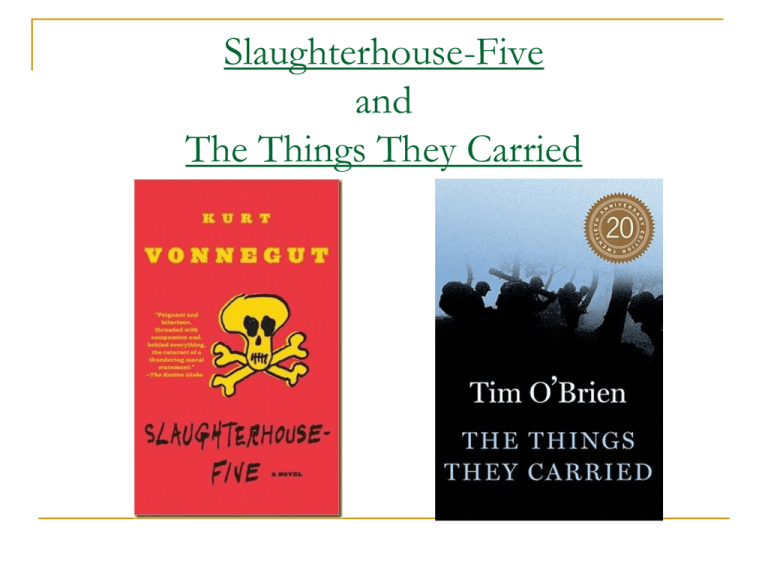
Slaughterhouse-Five and The Things They Carried Vonnegut & O’Brien Articles Each pair will read the two articles Vonnegut: pink O’Brien: white Take notes on the important and relevant information Share your info w/ your partner We will discuss the articles as a class Food for Thought: Quickwrite Only the dead have seen the end of war. George Santayana Does the quote above hold truth? Why or why not? Is war necessary? Explain. Kurt Vonnegut Born November 11, 1922, in Indianapolis, Indiana Died April 12, 2007 in New York, New York Education Attended Cornell University; majored in chemistry and biology After college, Vonnegut enlisted in the United States Army, serving in the World War II Following the war, Vonnegut studied anthropology at the University of Chicago World War II Experiences as POW in Germany had profound influence of his writing, including Slaughterhouse Five. While a POW, witnessed firsthand the firebombing of Dresden, Germany, by Allied forces in 1945. Experience in Dresden = the basis for Slaughterhouse-Five, which was published in 1969 Vonnegut on what he saw in Dresden “The firebombing of Dresden,” Vonnegut wrote, “was a work of art.” It was, he added, “a tower of smoke and flame to commemorate the rage and heartbreak of so many who had had their lives warped or ruined by the indescribable greed and vanity and cruelty of Germany.” Critical Reception and Censorship Slaughterhouse Five, wrote the critic Jerome Klinkowitz, “so perfectly caught America’s transformative mood that its story and structure became best-selling metaphors for the new age.” Novel reached No.1 on best-seller lists, making Vonnegut a cult hero. Some schools and libraries have banned it because of its sexual content, rough language and scenes of violence. Understanding the Confusing Narrative Flow Slaughterhouse-Five = a nonlinear work; includes many flash-backs, flash-forwards, and changes in setting. At beginning of Chapter Two, non-linear structure will become clear. Non-linear structure sometimes described as holistic rather than mechanistic: conveys experience as a continuous whole Understanding the POV Central character (Billy Pilgrim) knows every event which has ever happened or will happen to him Each scene in Billy Pilgrim's life = a moment with an impact on the totality of his existence The worldview of the Tralfamadorians, the aliens who kidnap Billy during the course of the book, seems to express how Vonnegut would like the reader to experience the novel. Limits to the Structure Example of a clear transition between scenes in his life : "And then Billy was a middle-aged optometrist again...(Vonnegut, 85)", or "And Billy took a very short trip through time...” Vonnegut always alerts the reader to the shift in time and space, as though the flow of the novel were a tow rope which pulls the reader safely through a series of scenes. Diagram for Structure The structure of Slaughterhouse-Five looks like this: Each bullet represents a scene; numbers represent physical chronology; and the line represents narrative flow Motifs: Definition Motifs are recurring structures, contrasts, or literary devices that can help to develop and inform the text’s major themes. Look slide. for and trace the motifs listed on the next Motifs in Slaughterhouse Five “So it goes” “If the accident will” “an old fart with his memories and Pall Malls” “My name is Jon Jonson” “And so on” the smell of mustard gas and roses The Children's Crusade a dance with death “So it goes.” “Robert Kennedy, whose summer home is eight miles from the home I live in all year round,” Vonnegut wrote at the end of Slaughterhouse Five, “was shot two nights ago. He died last night. So it goes.” “Martin Luther King was shot a month ago. He died, too. So it goes. And every day my Government gives me a count of corpses created by military science in Vietnam. So it goes.” “So it goes.” One of many repeated, mantra-like words and phrases that run through Vonnegut’s books, “so it goes” became a catchphrase for opponents of the Vietnam war. Why might this phrase resonate with an anti-war audience? CHAPTER ONE Key to the novel is the opening section in which, apparently, the author speaks in his own voice about a visit he made to talk with an old war buddy, Barnard V. O'Hare, as he was completing the manuscript for the novel. It explains how the novel came to be outfitted with its subtitle ("Or The Children's Crusade | A Duty-Dance with Death") and how it came to be dedicated to O'Hare's wife. CHAPTER ONE Chapter One makes explicit the author's purpose in writing the novel, as well as his skepticism about whether there is any hope it might contribute to its intended effect. The Things They Carried An introduction to Tim O’Brien and his fictional account of the Vietnam War What Do You Need to Know About the Book Before Reading It? It is ALL fiction Facts are not important The emotional effect of incidents is what is important. Tim O’Brien (author) vs. “Tim O’Brien” (character, narrator) Protagonist and narrator is “Tim O’Brien”. This “Tim O’Brien” in the book is NOT REAL. Even when “Tim O’Brien” talks directly to the reader, it is the fictional “Tim”. Tim O’Brien The author Tim did actually go to Vietnam and really was in the Alpha Company, but is writing a fictional account. Abbreviations found in The Things They Carried Abbreviation Part of speech Definition SOP N Standard Operating Procedure CO N Commanding Officer PFC N Private First Class (rank) RTO N Radio Transmissions Officer LP N Language/Listening Patrol CS N Tear gas MRE N Meal ready to eat VC N Viet Cong
